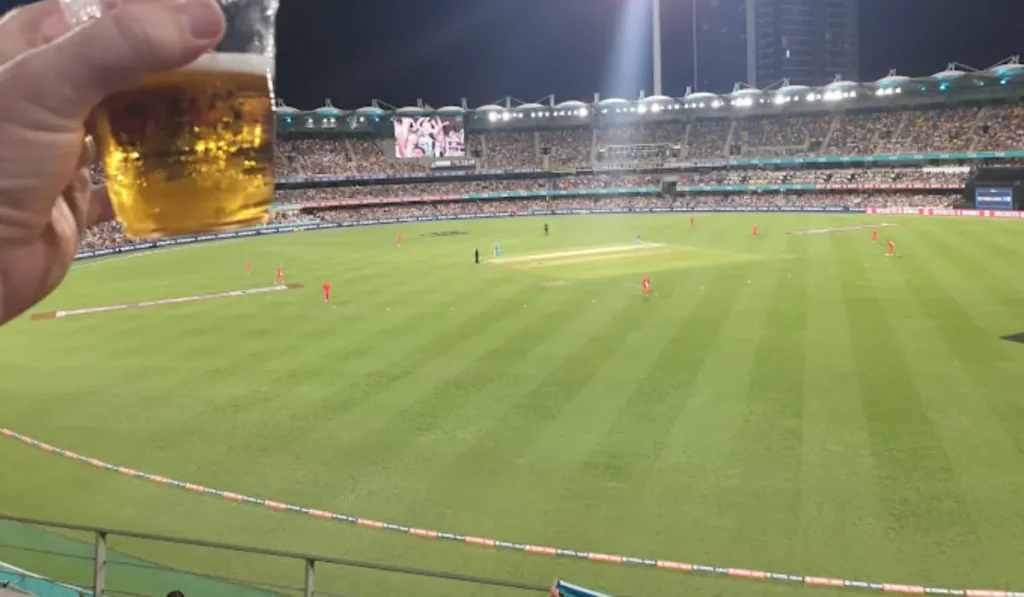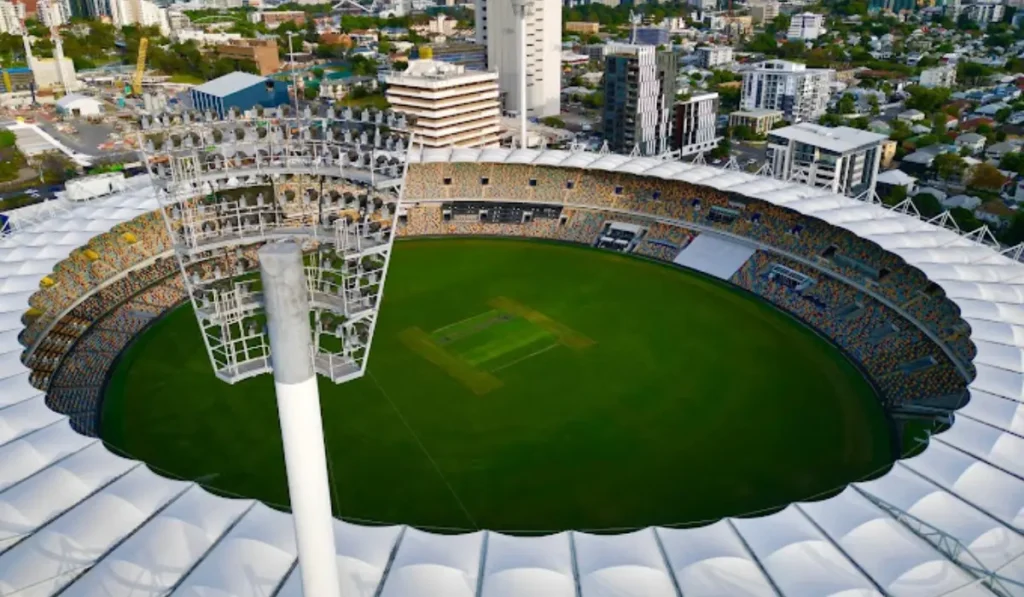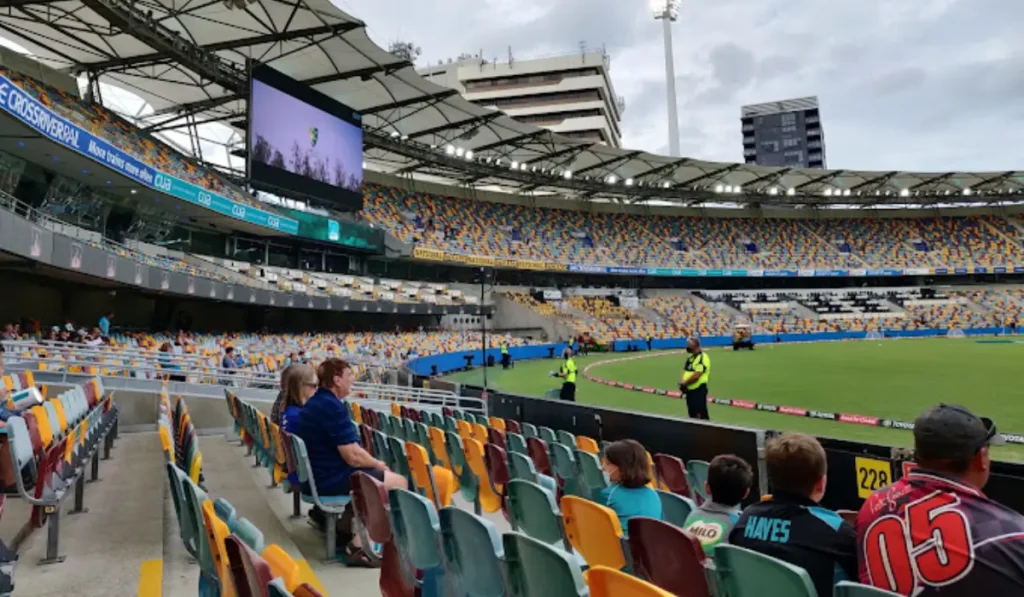The Gabba Stadium Pitch Report: T20, ODI, Tests is situated in Brisbane, Australia. It’s a major sports venue primarily used for cricket and Australian rules football. The Gabba stadium is used mainly for the cricket team and the Brisbane Heat in the Big Bash League. The stadium was established in 1895 and has undergone several renovations and expansions. It has hosted numerous domestic and international cricket matches, including Ashes test matches, one-day internationals, and T20 internationals. It also hosted the opening ceremony and athletics events during the 1982 Commonwealth Games. In the 2010-11 Ashes Test series, Australia won the match significantly, with Mitchell Johson’s outstanding bowling performance (9 wickets) being highlighted. In the 2013-14 ashes test match, Australia convincingly reclaimed the ashes from England. Mitchell Johnson’s fiery pace bowling terrorized the English batsmen, leading Australia to a comprehensive victory.
The Gabba Stadium Pitch Report: T20, ODI, Tests Overview
The stadium is known for its bouncy and fast-paced pitches, which favor fast bowlers. The stadium pitch offers a good carry and bounce, providing an exciting challenge for both batsmen and bowlers. Matches that won batting first- 26, matches won by batting second 26, matches won by winning the toss- 28, matches won by losing toss-24, highest individual innings- 259, scored by MJ Clarke (Australia), average runs per wicket- 32.22, average runs per over- 3.16, average score batting first- 332. The first test match was played in this stadium on 25 January 1931. First ODI matches were played in this stadium on 23 December 1979.
| Pitch name | The gabba stadium |
| Established | 1895 |
| Capacity | 42,000 |
| End names | Stanley street end, vulture street end |
| Location | Vulture St, Woolloongabba QLD Australia |
| Floodlights | Yes |
The Gabba Stadium pitch report
In the past, the Gabba Stadium Pitch Report: T20, ODI, Tests was a paradise for seamers. The pitch favors fast bowlers. The surface is usually complex and conducive to seam bowling during the early stages of a match, especially in overcast conditions. As the game progresses, the pitch tends to flatten out, offering good batting conditions with true bounce; the spinners can also play in the later stages. The outfield is fast, enabling quick runs, and the stadium’s location in Brisbane means that weather conditions can influence pitch behavior, with hot and humid conditions favoring spinners. Overall, the gabba pitch often provides an exciting contest between bat and ball, with something in every type of cricket.
The distance is standard for most cricket grounds hosting international matches and is designed to provide a fair balance between bat and ball while ensuring spectator safety. The distance is measured from the pitch to the perimeter of the playing area and varies slightly based on the ground layout and specific match regulations.
| Pitch type | Bouncy pitch |
| For pacers | Assistant |
| For spinners | Spin friendly |
| Toss | 28 (42.42%) |
| For batsmen | Responsive |
Read More:
Gabba Stadium Records & Stats
| Total Matches | 154 |
| Average 1st Inning Score | 332 in Tests, 222 in ODIs, 166 in T20Is |
| Highest Total Recorded | 645 by Australia vs England in Tests 324/7 by Australia vs West Indies in ODIs 209/3 by Australia vs South Africa in T20Is |
| Lowest Total Recorded | 58 by England/India vs Australia in Tests 71 by Pakistan vs West Indies in ODIs 114 by South Africa vs Australia in T20Is |
| Highest Score Chased | 329/7 by India vs Australia in Tests 309/3 by Australia vs India in ODIs 161/4 by Australia vs South Africa in T20Is |
| Highest Individual Score | 259* by Michael Clarke for Australia vs South Africa in Tests 63 by David Warner for Australia vs Sri Lanka in ODIs 96 by Damien Martyn for Australia vs South Africa in T20Is |
| Best Bowling Performance | 9/52 by Richard Hadlee for New Zealand vs Australia in Tests 6/45 by Chris Woakes for England vs Australia in ODIs 4/20 by Mitchel Starc for Australia vs West Indies in T20Is |
Australia Record at Gabba Stadium
| Played | 115 |
| Won | 71 |
| Lost | 26 |
| Tied | 1 |
| Draw | 13 |
| No Result | 4 |
Australia Test Record at Gabba Stadium
| Played | 66 |
| Won | 42 |
| Lost | 10 |
| Tied | 1 |
| Draw | 13 |
| No Result | 0 |
Australia ODI Record at Gabba Stadium
| Played | 42 |
| Won | 23 |
| Lost | 15 |
| Tied | 0 |
| Draw | 0 |
| No Result | 4 |
Australia T20I Record at Gabba Stadium
| Played | 7 |
| Won | 6 |
| Lost | 1 |
| Tied | 0 |
| Draw | 0 |
| No Result | 0 |
What is the seating capacity of the Gabba stadium?
The Gabba stadium has a seating capacity of 42,000. With its large seating capacity, the Gabba can attract many fans, creating an amazing atmosphere during matches and events. The stadium’s design was excellent. They are allowing the fans to enjoy the action from every vantage point. In the thrilling cricket match, the Gabba Stadium provides an unforgettable experience for sports lovers.
What is the boundary distance of the Gabba stadium?
The boundary distance at the Gabba stadium –
a).The most considerable boundary distance is 85 meters
b).The smallest boundary distance is 65 meters
The considerable boundary distance allows the batters to score runs more easily by hitting boundaries. They have a better chance of hitting boundaries. On the other side, the large boundary distance also benefits bowlers. They have a more significant margin for errors than stadiums with shorter boundaries. The boundary distance at the stadium provides a balanced contest between bat and ball, offering opportunities for both batters and bowlers to excel based on their skills to play for matches.
What is the highest total at the Gabba Cricket Stadium?
Australia scored the highest total at the Gabba Stadium Pitch Report: T20, ODI, Tests in ODI matches; Australia scored 324/7 runs in 1st innings against West Indies on 14 February 2010. In the T20 match, Australia again scored the highest team total at the stadium, scoring 209/3 runs in 20.0 overs in 1st innings against South Africa.
Highest totals | Team | Against | Date | |
| Test | 645 | Australia | England | 29/11/1946 |
| T20 | 209/3 | Australia | South Africa | 09/01/2006 |
| ODI | 324/7 | Australia | West Indies | 14/02/2010 |
What is the lowest total at the Gabba stadium?
In the Gabba stadium, India scored the lowest total in test matches; India scored 58 runs in 21.3×8 overs against Australia on 28 November 1947. In that match, Australia scored 382/8d and won by 226 runs. Donald Bradman was the player in that match, securing 185 runs in 336 balls.
Lowest totals | Team | Against | Date | |
| Test | 58 | India | Australia | 28/11/1947 |
| T20 | 114 | South Africa | Australia | 09/01/2006 |
| ODI | 71 | Pakistan | West Indies | 09/01/1993 |
Who scored the most runs at the Gabba stadium?
In test matches, RT Ponting from Australia scored 1335 runs in 26 innings at an average of 63.57. CA Hodges from England scored the most runs in the women’s test match; she scored 127 runs in 2 innings with an average of 63.5.
Players | Most runs | Batting average | No of matches | |
| Test | RT Ponting (Australia) | 1335 | 63.57 | 17 |
| T20 | DA Warner (Australia) | 145 | 48.33 | 4 |
| ODI | DM Jones (Australia) | 513 | 57 | 9 |
Who took the most wickets at the Gabba stadium?
In test matches, SK Warne from Australia took the most wickets, 68 wickets in 22 innings at an average of 20.3, and in the women’s test match, CL Fitzpatrick took most of the wickets; she took eight wickets in 2 innings at an average of 7.5.
Players | Wickets | Bowling average | No. of matches | |
| Test | SK Warne (Australia) | 68 | 20.3 | 11 |
| T20 | A Zampa (Australia) | 7 | 13.57 | 4 |
| ODI | GD McGrath (Australia) | 21 | 16.28 | 10 |
What are the best bowling figures in an innings at the Gabba stadium?
In ODI matches, the best bowling figure in an innings was CR Woaker from England; he took six wickets in 10.0 overs against Australia on 30 January 2011. Sir RJ Hadlee took 9 wickets in 23.4 overs against Australia.
Players | Best bowling figures | Against | Match date | |
| Test | Sir RJ Handle (New Zealand) | 9/52 | Australia | 08/11/1985 |
| T20 | MA Starc (Australia) | 4/20 | West Indies | 07/10/2022 |
| ODI | CR Woakes (England) | 6/45 | Australia | 30/01/2011 |
What are the best bowling figures in a match at the Gabba stadium?
In the T20 match, MA Strac was the best bowler; he took four wickets and 4.0 overs against West Indies. In the women’s ODI matches, KV Gunn took four wickets, 10.0 overs against Australia on 17 January 1993 at the Gabba stadium.
Players | Best bowling figures | Against | Match date | |
| Test | Sri RJ Handle (New Zealand) | 9/52 | Australia | 08/11/1985 |
| T20 | MA Starc (Australia) | 4/20 | West Indies | 07/10/2022 |
| ODI | CR Woakes (England) | 6/45 | Australia | 30/01/2011 |
What are the highest partnerships at the Gabba stadium?
The highest partnership for any wicket was IJL Trott and AN Cook from England, they scored 329 runs against Australia on 25 November 1010 test match. MEK Hussey and BJ Haddin were the second-highest partners in the test match from Australia; they scored 307 runs together. In the women’s ODI match, the highest partners were BJ Clark and DA Annetts from Australia, who scored 121 runs in 2 wickets against New Zealand. In the ODI match, ME Waugh and AC Gilchrist scored 206 runs from the Australian team against West Indies. SM Katich and AC Gilchrist were also the highest partners at the Gabba cricket stadium.
The Gabba Stadium Photos
The Gabba Stadium Location
FAQs
Why is Gabba a fortress for Australia?
The Gabba, officially known as the Brisbane Cricket Ground, is called the Fortress for Australia because of its record. The Australian cricket team never lost a test at this stadium for 32 years between 1989 and 2021.
How big is the Gabba?
The Gabba is a decent-sized cricket stadium that can hold up to more than 37,000 people to its maximum capacity.
What type of pitch is Gabba?
The pitch at Gabba or Brisbane Cricket Ground is a fast and bouncy surface, just like in Perth, where fast bowlers wreak havoc on batters.







